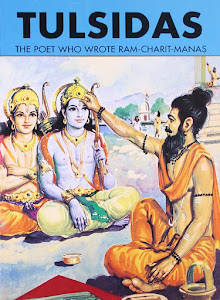Tulsidas was popularly known as Goswami Tulsidas. He was a poet and author of “Ramachariths Manas”, “Hanuman chalis”, “Parvati Mangal” and many other religious scripts based on epic episodes. He was a saint, reformer and philosopher renowned for his devotion to Lord Sri Rama. He was acclaimed as a reincarnation of sage Valmiki, the author of first and the original Ramayana in Sanskrit. At the end of his life he suffered from very painful boils, which resulted in causing disability to his arms and at that juncture he composed Hanuman Bahuk, praising the strength, glory and virtue of Lord Hanuman, and got rid of the disability.
The most popular episode in the life story of Tulsidas is that he was very lucky to have darshan of Lord Sri Rama. The incident goes thus:
Tulsidas used to pour water to a banyan tree after his morning ablutions. Because of his service the spirit that was dwelling on the tree due to certain curse was cured and relieved of its curse. It appeared before Tulsidas to express gratitude to him and asked what he wished from that spirit. He expressed his desire to have holy darshan of Lord Sri Rama. The spirit informed him a secret as well as a fact that Hanuman was attending his (Tulsidas) discourses on Ramayana every day. Hanuman would come first and goes at the end when all the audience left the auditorium and that Hanuman could help him to see Sri Ram. The next day Tulsidas observed the old man in the audience sitting at the corner end of the hall. Soon after the discourse when the old man left the place Tulsidas followed him and fell at the feet of old man. No doubt he was Hanuman. Old man assuming his real form asked Tulsidas to go to Chitrakut, where his desire would be fulfilled. Accordingly he went to Chitrakut. There he prepared sandal paste and offered it to the devotees who visited him. Fortune followed Tulsidas. One day when he was preparing sandal paste Lord Sri Ram appeared before him and asked for some sandal paste. On seeing the most virtuous Lord of Lords Sri Rama Tulsidas was overwhelmed and went into Samadhi. Then Sri Ram pasted sandal paste on the forehead of Tulsidas in His own hand. Tulsidas said to have remained in Samadhi continuously for three days as that was the first time he experienced Samadhi and had the darshan of his revered Lord Sri Rama.
It is well known that Lord Hanuman would always be present in disguise wherever and whenever the name ‘Ram’ is being uttered and especially Ramayana story is narrated, sung, played on stage.
It is most deserving to name a garden in his name at Ayodhya as it has all relevance to the place as well as the saint, an ardent devotee of lord Sri Rama. The garden is located on the National Highway of Faizabad. Earlier, it was named after Queen Victoria as ‘Victoria Park’ and there was a statue of Queen Victoria in the centre of the park. That was made only to please the British bosses during the slave period prior to independence. Many years after independence the sanity downed on our elected representatives and named this park and dedicated to Santh (saint) Tulsidas in 1960. I wish this example must be followed by all the governments in the country and remove those statues and names of the British rulers and officers who exploited us for centuries and replace them with Indian names and leaders as has been don e by the state government in Uttar Pradesh. I think the credit goes to the state government of Uttar Pradesh for setting up an example in this direction and adopting changes matching the trend of the present days.
The garden is beautiful and one can spend some useful time while relaxing here.
Ayodhya and Faizabad are twin cities and well connected with Lucknow, Varanasi, Gorakhpur and Allahabad. The nearest airports are those of Lucknow (135 km) and Varanasi (200 km). Ayodhya is 6 km (4 mi) from Faizabad. It has good road connectivity with Lucknow (135 km), Varanasi (200 km), Allahabad (165 km) and Gorakhpur (175 km). The Railway network connects Ayodhya directly with Lucknow (three hours) and Varanasi (four hours). Bangalore is at about 2350kms from Ayodhya. In summer (March to July) the temperatures would range from 35 to 45 degrees Celsius and in winters (November to January) from 6 to 25 degrees Celsius. Rainy season is during monsoon of July to September.


